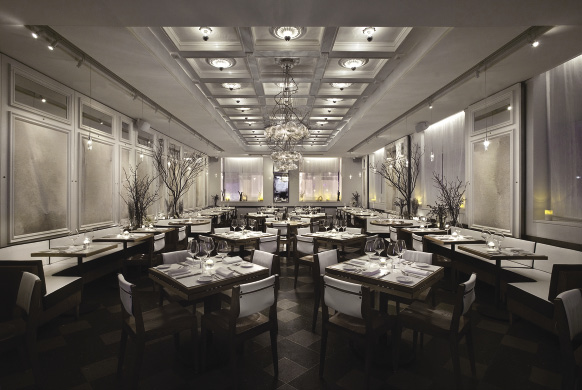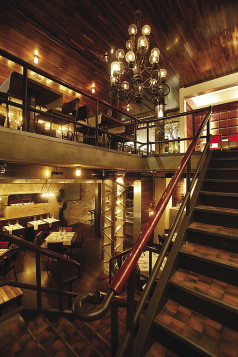- Home
- Media Kit
- Current Issue
- Past Issues
- Ad Specs-Submission
- Ad Print Settings
- Reprints (PDF)
- Photo Specifications (PDF)
- Contact Us

![]()
ONLINE

Fueling Fourth Wall
Editors’ Note
Michael Stillman graduated from Brown University with a double degree in Modern and Contemporary Painting and African-American Political Theory. He then worked for Union Square Hospitality Group before learning the business of The Smith & Wollensky Restaurant Group from the ground up. After stints in the restaurants’ kitchens and purchasing departments, Stillman played a critical role in the opening of Smith & Wollensky restaurants in Houston, Dallas, and Boston. He later channeled his creative vision and business sense into the concept creation of Quality Meats, which opened in 2006. Stillman then envisioned an ephemeral concept that literally changed throughout the year in tune with New York’s seasons, in the space that had been Park Avenue Café. It was made a reality to critical and popular acclaim. In its first 12 months of operation, Park Avenue (Autumn, Winter, Spring, Summer) grew revenues by more than 50 percent of the recent revenues achieved by the previous occupant of that space. In 2011, Stillman added another concept to the company portfolio, with The Hurricane Club, a modern Polynesian supper club, expanding the group’s presence from the New York midtown neighborhood to downtown. In 2012, Stillman oversaw the revitalization of Maloney & Porcelli to much acclaim.
Company Brief
Fourth Wall Restaurants (fourthwallrestaurants.com) was founded in 2007 by acclaimed father-son restaurateurs Alan and Michael Stillman. The group is comprised of upscale restaurants and nightlife venues in New York City, including the flagship Smith & Wollensky location, Maloney & Porcelli, Park Avenue, The Post House, Quality Meats, The Hurricane Club, and Riff Raff’s. In 2013, the Stillmans will be expanding the portfolio with the addition of Quality Italian.
How do you define the Fourth Wall brand?
It’s a multigenerational company. There is a history in New York of different concepts and ours are a bit more diverse. I’ve been involved in Quality Meats, Park Avenue, The Hurricane Club, and Riff Raff’s, which were all newer concepts. But there is a link naturally to our older spaces: Smith & Wollensky, The Post House, and Maloney & Porcelli. I recently did renovations on Maloney & Porcelli, tweaking the concept. They are different in that they didn’t originate with me design-wise and they have a distinct look and feel.
There are certain key differences that unite all six properties, but we have a four and three feel to our company.

Quality Meats
What defines service and quality for the properties?
What defines our service and quality both on the front end and back of house is growth from within. My chef/partner is a relative newcomer, but he’s been with us long enough to have been brought into that culture. It’s a different mentality when you have people who have been with you long term and have worked their way up and that starts to redefine the attitude to one of ownership within the staff.
These are all upscale restaurants but there is a warm feel to them. Is that challenging to maintain when you’re dealing with high-end clientele?
It’s challenging because it’s about being able to do significant volume while maintaining that service level. It’s tied to individual ownership and attitude because when you have a 140-seat restaurant and the owner is not there day in and day out, you define the place by what decision-making your staff is going to do on their own that is related to your core culture. The warmth is genuine because when you walk into one of our places, the person serving feels like the owner of the place he’s working in.

Park Avenue Winter
Each of these restaurants has a loyal following. Are you focused on growing the brand?
Yes, and we’re actively pursuing different ventures. But it’s important in the restaurant business to find the right growth that you still have passion for so you can bring to fruition the concept and how it’s meant to be.
It’s tougher to do at high-end restaurants than it is in a more casual restaurant, because there are so many moving parts and there is so much individual attention needed to grow the right way, especially once you get out of any one city. We opened a restaurant in Houston and one in Dallas. You have to understand the audience of each place and relate to them from a food, atmosphere, and style of service perspective.
You have to grow the right way. We are looking at space outside of New York and we’re looking at key cities where we can do multiple concepts.
What was your vision for The Hurricane Club and has it become what you expected?
Our restaurants in New York are predominantly in midtown. The Hurricane Club is more of a downtown concept and targeted to a bit of a younger audience.
Conceptually, the idea of doing a contemporary Trader Vic’s fit with us because it had a lot of high design and that is important to us in all of our restaurants. There is also a lot of detail in the food and the service. That appeals to me and my father and all of our restaurants have that element.
In doing the project, we have witnessed a scene building and that is even more important for that younger audience and something different for us.
The concept has been very successful and it’s possible we’ll do more of them.
How do you avoid becoming complacent and remain focused on innovating?
You don’t want to mess too much with something that is successful, but I have to continue to evolve and bring the same intensity that I brought to a restaurant when it was initially successful and find ways to continue to make it smart – otherwise, it loses its steam.
Smith & Wollensky is a good example because, in 35 years, it remains committed to its core base. You don’t want to mess with that. However, you can definitely tweak it.
This is where the balance lies. Messing with the core is dangerous, but thinking that everything you do is core is equally dangerous because that hinders innovation.
With Quality Meats, we tinker with a lot of our dishes and we always look at our service style but all within the balance of what we believe is core to what we are.
Do customers understand that while you might be paying more, you can still get a great value?
It’s a balance. People have a different mentality now on value. It helps if you feel you’re bringing good value at your particular price point.
It also helps if more people understand how much you care about the product you’re giving them. It’s about getting them more involved with the process; don’t just say, we have a special wine, but tell them how you’ve met the winemaker and worked with the chef and sommelier. There is strong value in relaying an experience to the guest and in making sure your people understand the product they are giving the customer so the customer gets that understanding as well.•